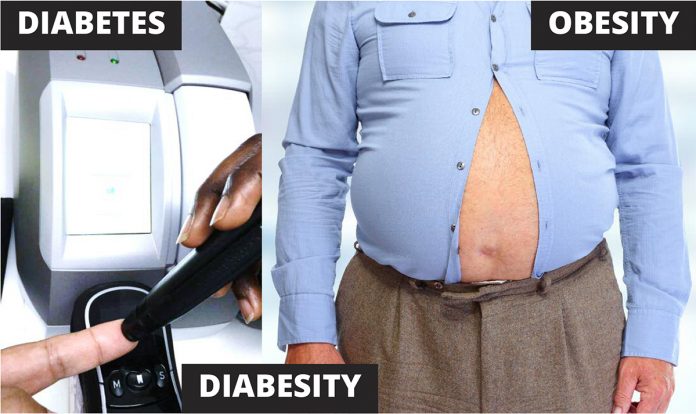Chester Medical school shed light on the link between obesity and diabetes, the challenge facing patients with ‘Diabesity’ and the research contribution of the school in solving this problem
The UK has the highest prevalence of diabetes in the whole of Europe (with 3.7 million patients) and approximately 90% of these are Type 2 diabetes mellitus (T2DM). Approximately 90% of these T2DM patients are either overweight or obese, hence the term ‘Diabesity’.
The link between diabetes and obesity
It is the chicken and the egg dilemma – does obesity cause diabetes or does diabetes cause obesity? Several pieces of evidence now suggest that obesity is one of the causes of the loss of insulin resistance that is characteristic of T2DM.
The first type of evidence is linked directly to fat metabolism. As we store fat, more specifically abdominal fat, our bodies enter a chronic inflammatory condition, particularly when the percentage of body fats exceed 30%. At this point body fat turns to ‘angry fat’ and starts to release several inflammatory cytokines and hormones. These inflammatory cytokines, for example, TNFα, inhibit glucose transporters and so reduce the sensitivity of our bodies to insulin.
Abdominal obesity, sometimes termed diabetogenic obesity, is reflected in the amount of fat stored in the cells of the pancreas. The β-cells in the pancreas are responsible for producing and releasing insulin into the blood, but this process is decreased as the pancreas stores fat. Thus, pancreatic fat inhibits insulin release and abdominal fat prevents cells from utilising glucose. These two actions result in insulin resistance and high blood sugar levels.
If T2DM is diagnosed before the impact of fat is permanent, it is possible to reverse this – i.e. by losing weight – either by diet or exercise, or both, then both insulin production and insulin sensitivity can be restored. So, curing T2DM is simple – weight loss and increase physical activity are the golden messages to prevent and control T2DM.
Why obese people with T2DM need to lose weight?
Clinical research and NICE obesity guidelines recommend 5-10% of weight loss in obese people with T2DM to decline HbA1c levels; to reduce the cardiovascular diseases (CVD) risk factors, and to limits the use of the anti-diabetic and anti-hypertension medications.
Why weight loss is challenging in people with T2DM?
Weight-loss can be difficult for people with existing T2DM for several reasons. Uncontrolled diabetes is associated with excessive hunger ‘polyphagia’ mainly because lack of insulin, or insulin resistance, maintains the glucose in the bloodstream rather than inside cells which means that tissues are unable to get the required energy for biological process and this increases hunger.
Several antidiabetic medications including, insulin, may promote weight gain because they have anabolic activities. Additionally, some antipsychotic medications that are used to treat the neuropathy associated with diabetes cause weight gain.
Food restriction increases the production of a hunger-stimulating hormone ‘Ghrelin’ and it also reduces satiety hormones such as leptin.
Chester Medical School’s role in tackling ’Diabesity’
Chester Medical School has a long-standing interest in the challenges facing patients with T2DM alone or combined with obesity. Professor John Williams, Associate Dean of the Faculty of Medicine, Dentistry and Life Sciences at the University of Chester says: “Chester Medical School has a significant research portfolio in biomedical and medical research, alongside its undergraduate and postgraduate programmes. We aim to utilise the expertise in the Medical School, to understand the mechanisms linking obesity, inflammation and Type 2 diabetes through research studies and to inform practice through our taught MSc Diabetes”.
Our long-standing research interest in heat shock proteins (HSPs) is being applied to diabetes research through the role of these in inflammatory reactions1. Previous research at Chester has found a novel beneficial role of folic acid (a form of vitamin B9) supplementation on reducing one of the stress proteins (HSP70) that indicates the severity of T2DM2. A European collaborative project found that step aerobics exercise combined with strength exercise for eight weeks showed a notable reduction in obesity markers3.
Currently, Chester Medical School is adopting two main approaches to tackle the diabesity problem, the first approach is to conduct several studies to test the influence of nutritional and probiotic supplements on obesity and diabetes parameters. The second approach includes running an MSc Diabetes programme to engage medical school students from different professional backgrounds in evidence-based practice – in common with other Chester Medical School MSc programmes. This will embed research in the mind of healthcare professionals – always willing to engage with and propose, novel management strategies for diabesity.
References
1 Hunter-Lavin et al., (2004, a). Hsp70 release from peripheral blood mononuclear cells. Biochemical and biophysical research communications, 324(2), 511-517.
2 Hunter-Lavin et al ,. (2004, b). Folate supplementation reduces serum hsp70 levels in patients with Type 2 diabetes. Cell stress & chaperones, 9(4), 344-349.
3 Pereira, et al.,(2013). Combined strength and step aerobics training leads to significant gains in maximal strength and body composition in women. J Sports Med Phys Fitness, 53(3 Suppl 1), 38-43.
Please note: this is a commercial profile
Professor John Williams
Associate Dean of the Faculty of Medicine, Dentistry and Life Sciences
Hanady Hamdallah
Medical Science Lecturer
Chester Medical School
Tel: +44 (0) 1244 513 860 (Ext 3860)











